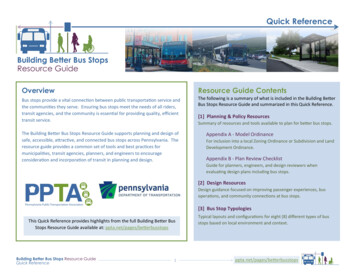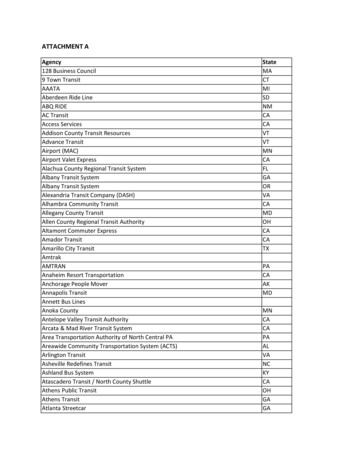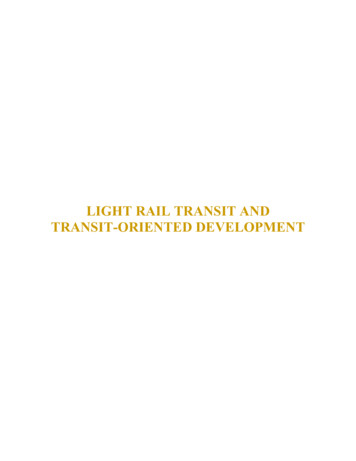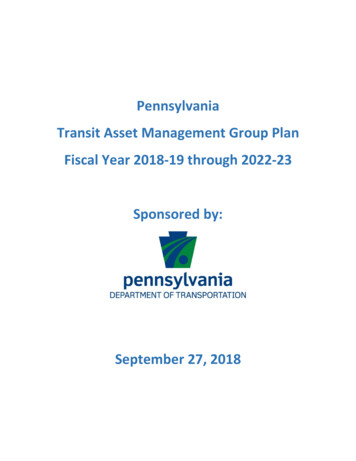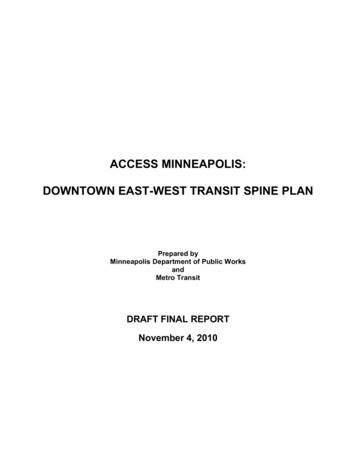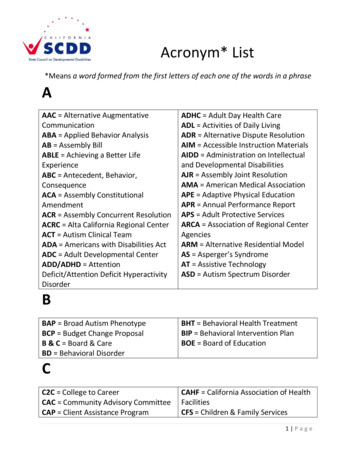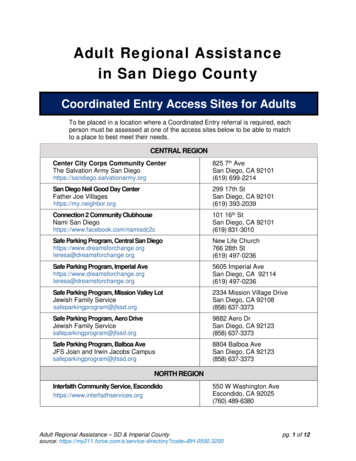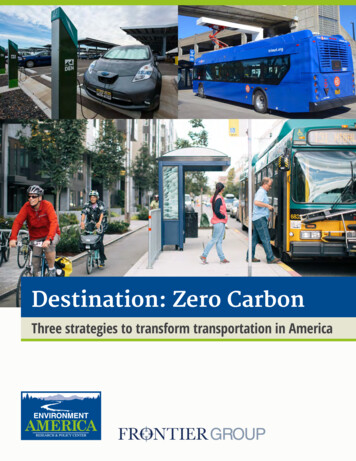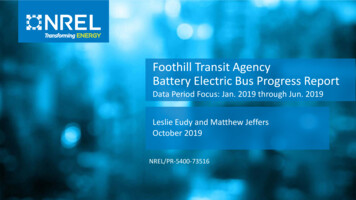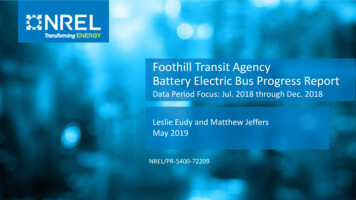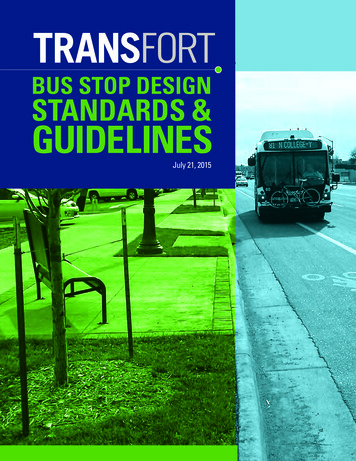
Transcription
Regional Coordinated Transit andHuman Services PlanAPPENDIX AGLOSSARY OF TERMSAppendix A
Regional Coordinated Transit andHuman Services PlanACCESSIBLE VEHICLE (OR WHEELCHAIR-ACCESSIBLE VEHICLE OR ADA ACCESSIBLE VEHICLE) - Publictransportation revenue vehicles, which do not restrict access, are usable, and provide allocated space and/orpriority seating for individuals who use wheelchairs, and which are accessible using ramps or lifts.ADVANCED GUIDEWAY SYSTEM (AGS) – A fully automated, driverless, grade-separated transit system in whichvehicles are automatically guided along a guideway. The guideway provides both physical support as well asguidance. The system may be elevated or at-grade. Examples include maglev systems, people mover systemsand monorail.AMERICAN RECOVERY AND REINVESTMENT ACT OF 2009 (ARRA) – Legislation passed in 2009 as an economicstimulus program to fund projects such as improving education, building roads, public transportation, criminaljustice, health care and others. The intent of the act is that it would result in jobs and other associated economicbenefits.AMERICANS WITH DISABILITIES ACT (ADA) – Federal civil rights legislation for disabled persons passed in 1990.It mandates that public transit systems make their services more fully accessible to the disabled. If persons withdisabilities are not capable of accessing general public transit service, the law requires agencies to fund andprovide for delivery of paratransit services which are capable of accommodating these individuals.AREA AGENCY ON AGING (AAA) A state-approved county or regional body responsible for administering Title IIIfunds within a particular geographical area. There are 16 AAAs in Colorado.ASSET MANAGEMENT – A systematic and strategic process of operating, maintaining, upgrading and expandingphysical assets effectively through their life cycles.BROKERAGE - A method of providing transportation where riders are matched with appropriate transportationproviders through a central trip-request and administrative facility. The transportation broker may centralizevehicle dispatch, record keeping, vehicle maintenance and other functions under contractual arrangements withagencies, municipalities and other organizations. Actual trips are provided by a number of different vendors.BUS RAPID TRANSIT (BRT) – BRT combines the quality of rail transit with the flexibility of buses. It can operateon exclusive transitways, HOV lanes, expressways, or ordinary streets. A BRT system combines IntelligentTransportation Systems (ITS) technology, priority for transit, lower emissions, quieter vehicles, rapid andconvenient fare collection, and integration with land use policy.CAPITAL COSTS – Refers to the costs of long-term assets of a public transit system such as property, buildings,equipment and vehicles. Can include bus overhauls, preventive maintenance, mobility management and even ashare of transit providers’ ADA paratransit expenses.CARPOOL – Arrangement made between a group of people that ride together to a designated place.CAR SHARE – Companies that own cars that can be rented by members for the hour or day and are convenientlylocated at designated locations (transit stations, downtown, etc.).COLORADO DEPARTMENT OF TRANSPORTATION (CDOT) - CDOT is primarily responsible for the design,construction, maintenance, and operation of Colorado Highway System, including the Interstate HighwaySystem within the state’s boundaries. Within CDOT, the Division of Aeronautics supports aviation interestsstatewide, the Division of Transit and Rail provides assistance to numerous transit systems around the state, andthe Bicycle and Pedestrian Program supports improvements to non-motorized facilities, such as bike paths, trailsand routes, and pedestrian walkways and trails. www.coloradodot.infoCOLORADO TRANSPORTATION COMMISSION – The state’s transportation system is managed by the ColoradoDepartment of Transportation under the direction of the Transportation Commission. The commission isAppendix A-2
Regional Coordinated Transit andHuman Services Plancomprised of 11 commissioners who represent specific districts. Each commissioner is appointed by theGovernor, confirmed by the Senate, and serves a four-year term. The Transportation Commission is responsiblefor formulating general policy with respect to the management, construction, and maintenance of the state’stransportation system; advising and making recommendations to the Governor and the General Assemblyrelative to transportation policy; and promulgating and adopting CDOT’s budgets and programs, includingconstruction priorities and approval of extensions of abandonments of the state highway ommissionCOMMUTER RAIL – A transit mode that is an electric or diesel propelled railway for urban passenger trainservice consisting of local short distance travel operating between a central city and adjacent suburbs. Service isoperated on a regular basis by or under contract with a transit operator for the purpose of transportingpassengers within urbanized areas, or between urbanized areas and outlying areas.COUNCIL OF GOVERNMENTS (COG) – A voluntary association of local governments that operates as a planningbody, collects and disseminates information, reviews applications for funding, and provides services common toits member agencies.COMMUNITY CENTERED BOARDS (CCBS) – Private non-profit agencies that provide services to thedevelopmentally disabled population. CCBs provide a variety of services, including transportation.COORDINATION – A cooperative arrangement among public and private transportation agencies and humanservice organizations that provide transportation services. Coordination models can range in scope from shareduse of facilities, training or maintenance to integrated brokerages of consolidated transportation serviceproviders. Coordination also means the cooperative development of plans, programs and schedules amongresponsible agencies and entities to achieve general consistency, as appropriate.COORDINATED PUBLIC TRANSIT-HUMAN SERVICES TRANSPORTATION PLAN (COORDINATED PLAN) – a locallyor regionally developed, coordinated plan that identifies the transportation needs of individuals with disabilities,older adults, and people with low incomes, provides strategies for meeting those needs, and prioritizestransportation services for funding and implementation. The Federal Transit Administration (FTA) requires that aproject be included in a Coordinated Plan to be eligible for certain federal transit funds.CURB-TO-CURB – A form of paratransit or demand-response service that picks up passengers at the curbside.DEADHEAD – The time/distance that a transit vehicle does NOT spend in revenue service or moving passengers,as in the movement from the garage to the beginning of a route.DEMAND-RESPONSE SERVICE – Personalized, direct transit service where individual passengers requesttransportation from a specific location to another specific location at a certain time. Transit vehicles providingdemand-response service do not follow a fixed schedule or a fixed route, but travel throughout the communitytransporting passengers according to their specific requests. Can also be called “dial-a-ride,” “paratransit” or“specialized service” to refer to any non-fixed route service. These services usually, but not always, requireadvance reservations and are often provided for elderly and disabled persons.DEVIATED FIXED ROUTE – Provides service along a fixed route with deviations to pick up special riders (e.g.,elderly and disabled persons) without significantly detracting from its schedule.DISABLED – Any person who by reason of illness, injury, age, congenital malfunction or other permanent ortemporary incapacity or disability, is unable, without special facilities, to use local transit facilities and services aseffectively as people who are not so affected.DIVISION OF TRANSIT AND RAIL (DTR) – A division within the Colorado Department of Transportation (CDOT)responsible for transit and rail policy, planning, funding and oversight. DTR was created in 2009 to promote,Appendix A-3
Regional Coordinated Transit andHuman Services Planplan, design, build, finance, operate, maintain and contract for transit services, including, but not limited to bus,passenger rail and advanced guideway systems. The Division is also responsible for administering and expendingstate and federal transit funds, integrating transit and rail into the statewide transportation system, anddeveloping a statewide transit and passenger rail plan as part of the multimodal statewide transportation plan.DOOR-TO-DOOR SERVICE – A form of paratransit or demand –response service that includes passengerassistance between the vehicle and the door of the passengers’ home or other destination. A higher level ofservice than curb-to-curb, yet not as specialized as “door-through-door” service.DOOR-THROUGH-DOOR SERVICE – A form of paratransit or demand-response service that includes passengerassistance between the vehicle and within the home or destination. A higher level of service than curb-to-curband door-to-door service.ENVIRONMENTAL JUSTICE (EJ) – Refers to the fair treatment of all people, regardless of race, color, nationalorigin or income in terms of the distribution of benefits and costs of federal programs, policies and activities.Executive Order 12898, signed by President Clinton on February 11, 1994, requires procedures be established toprotect against the disproportionate allocation of adverse environmental and health burdens on a community’sminority and low-income populations.FARE BOX RECOVERY – The amount of revenue generated through fares by paying customers as a fraction ofthe total operating expenses.FEDERAL HIGHWAY ADMINISTRATION (FHWA) – The agency within the U.S. Department of Transportation thatprovides funding for the construction, maintenance and preservation of the nation’s highways, bridges andtunnels. www.fhwa.dot.govFEDERAL TRANSIT ADMINISTRATION (FTA) – The agency within the U.S. Department of Transportation thatadministers federal funding to support a variety of locally planned, constructed, and operated publictransportation systems throughout the U.S., including buses, subways, light rail, commuter rail, streetcars,monorail, passenger ferry boats, inclined railways, and people movers. FTA provides financial assistance forcapital, operating, administration and planning costs of these public transportation systems. www.fta.dot.govFEDERAL RAILROAD ADMINISTRATION (FRA) – The federal agency within the U.S. Department ofTransportation that oversees certain aspects of rail services, especially safety issues. The FRA promulgates andenforces rail safety regulations, administers railroad assistance programs, conducts research and developmentin support of improved railroad safety and national rail transportation policy, among other things.www.fra.dot.govFIXED ROUTE – Transit services where vehicles run on regular, scheduled routes with fixed stops and nodeviation. Typically, fixed-route service is characterized by printed schedules or timetables, designated bus stopswhere passengers board and alight and the use of larger transit vehicles.FUNDING AGENCY - Any organization, agency, or municipality that funds transportation services by contractingwith another organization, agency, or municipality to provide the service. This does not include organizationsthat provide travel vouchers, subsidies, stipends, reimbursements, or other travel assistance directly to theirclients for travel on public transit, paratransit, taxi services, other agency-sponsored transportation, or in privatevehicles.FUNDING ADVANCEMENT FOR SURFACE TRANSPORTATION AND ECONOMIC RECOVERY (FASTER) ACT –Signed into law in 2009, FASTER provides state funds from an increase in vehicle registration fees to improveroadways, repair unsafe bridges, and support and expand transit. FASTER generates approximately 200 millionevery year for transportation projects across Colorado. Of this, 15 million annually goes to fund publicAppendix A-4
Regional Coordinated Transit andHuman Services Plantransportation/transit projects statewide. Additional money is provided for city roads (approx. 27 millionannually) and county roads (approx. 33 million annually). http://www.coloradodot.info/projects/fasternewHEAD START – A federal program that provides support to children, birth to age five, that come from lowincome families by improving their physical, social and emotional development. Head Start programs aretypically managed by local nonprofit organizations and are in almost every county in the country.HEADWAY – The time interval between the passing of successive transit buses or trains moving along the sameroute in the same direction, usually expressed in minutes. It may also be referred to as service frequency.HIGHWAY TRUST FUND (HTF) – is a federal transportation fund, established in 1956 to finance the InterstateHighway System. In 1982, the Mass Transit Fund was created and a portion of the HTF also funds transitprojects. Revenue for the HTF is generated by the federal fuel tax (18.4 cents per gallon on gasoline and 24.4cents per gallon of diesel fuel), which has not increased since 1993.HIGHWAY USERS TAX FUND (HUTF) – A state transportation fund, primarily funded by a motor fuel tax of 22cents per gallon. Colorado’s gas tax has been 22 cents since 1991. Funds are distributed based on a formula toCDOT, counties, and municipalities. Counties are authorized to flex HUTF dollars to transit, multimodal, bicycle,and pedestrian projects.HUMAN SERVICES TRANSPORTATION - Transportation for clients of a specific human or social service agencythat is usually limited to a specific trip purpose (e.g., Medicaid, Title III, etc.). Human service agency trips areoften provided under contract to a human service agency and may be provided exclusively or rideshared withother human service agencies or general public service.INTERCITY TRANSPORTATION - Long distance service provided between at least two urban areas or thatconnects rural areas to an urbanized area, usually on a fixed route, and often as part of a large network ofintercity bus operators. Both express and local bus service may be provided. The Greyhound and Trailwayssystems are examples national intercity bus networks. Under the Federal Transit Administration’s Section5311(f) program, intercity transportation service must receive no less than 15 percent of each state's totalSection 5311 funding, unless a state's governor certifies that these needs are already being met.ITS (INTELLIGENT TRANSPORTATION SYSTEMS) – Technical innovations that apply communications andinformation processing to improve the efficiency and safety of ground transportation systems.LAST MILE CONNECTION – Refers to the challenge of getting people from transit centers/stations to their finaldestination. Last mile connections can be made by walking, biking, shuttles, local bus routes, etc.LIGHT RAIL – A transit mode that typically is an electric railway with a light volume traffic capacity characterizedby vehicles operating on fixed rails in shared or exclusive right-of-way. Vehicle power is drawn from an overheadelectric line (catenary).LIMITED ENGLISH PROFICIENT (LEP) PERSONS - Refers to persons for whom English is not their primarylanguage and who have a limited ability to read, write, speak, or understand English. It includes people whoreported to the U.S. Census that they speak English less than very well, not well, or not at all.LOW-INCOME PERSON – A person whose median household income is at or below the U.S. Department ofHealth and Human Services (HHS) poverty guidelines.LOW-INCOME POPULATION –Refers to any readily identifiable group of low-income persons who live ingeographic proximity, and, if circumstances warrant, geographically dispersed/transient person who will besimilarly affected by a proposed DOT program, policy or activity.Appendix A-5
Regional Coordinated Transit andHuman Services PlanMAGLEV (Magnetic Levitation) – A high-speed form of transit that moves along a fixed guideway by means ofmagnetic forces that vertically lift the vehicle from the guideway to propel it forward.MOVING AHEAD FOR PROGRESS IN THE 21ST CENTURY ACT (MAP-21) – A two-year funding and authorizationbill to govern the United States federal surface transportation spending passed by Congress June 29, 2012 andsigned into law by President Obama on July 6, 2012.MATCH - State or local funds required by various federal or state programs to complement funds provided by astate or federal agency for a project. A match may also be required by states in funding projects that are jointstate/local efforts. Some funding sources allow services, such as the work of volunteers, to be counted as an inkind funding match. Federal programs normally require that match funds come from other than federal sources.METROPOLITAN PLANNING ORGANIZATION (MPO) – The agency designated by law as responsible for carryingout the transportation planning process and developing transportation plans and programs within an urbanizedarea. MPOs are established by agreement between the Governor and the local governments. There are fiveMPOs in Colorado.MINORITY PERSONS - includes the following:(1) American Indian and Alaska Native, which refers to people having origins in any of the originalpeoples of North and South America (including Central America), and who maintain tribal affiliation orcommunity attachment.(2) Asian, which refers to people having origins in any of the original peoples of the Far East, SoutheastAsia, or the Indian subcontinent, including, for example, Cambodia, China, India, Japan, Korea, Malaysia,Pakistan, the Philippine Islands, Thailand, and Vietnam.(3) Black or African American, which refers to people having origins in any of the Black racial groups ofAfrica.(4) Hispanic or Latino, which includes persons of Cuban, Mexican, Puerto Rican, South or CentralAmerican, or other Spanish culture or origin, regardless of race.(5) Native Hawaiian or Other Pacific Islander, which refers to people having origins in any of the originalpeoples of Hawaii, Guam, Samoa, or other Pacific Islands.MODE/INTERMODAL/MULTIMODAL - Mode refers to a form of transportation, such as automobile, transit,bicycle, and walking. Intermodal refers to the connections between modes, and multimodal refers to theavailability of transportation options within a system or corridor.MODE SHARE – Indicates the share of a transportation mode utilized by people for their transportation trips ascompared to other modes and all of a region’s transportation trips as a whole.MONORAIL – Guided transit vehicles operating on or suspended from a single rail, beam or tube.NATIONAL TRANSIT DATABASE (NTD): Annual reports (formerly known as “Section 15” reports) that providefinancial and operating data that are required of almost all recipients of transportation funds under Section5307. www.ntdprogram.gov/ntdprogram/NON-EMERGENCY MEDICAL TRANSPORTATION (NEMT) - A form of medical transportation that is provided innon-emergency situations to people who require special medical attention. Often a form of human servicetransportation and a resource of Departments of Health and Human Services.Appendix A-6
Regional Coordinated Transit andHuman Services PlanOLDER AMERICANS ACT (OAA) – An act passed in 1965 to addresses the needs of older adults and providecomprehensive services to those at risk of losing their self dependence .The act focuses on boosting the income,housing, health, employment, retirement and community services for older adults.OPERATING EXPENSES/COSTS – The sum or all recurring expenses (e.g., labor, materials, supplies, fuel andequipment) associated with the operation and maintenance of the transit system including maintain equipmentand buildings, operate vehicles, and to rent equipment and facilities.OPERATING REVENUES – All funds generated from the operation of a transit system, including passenger fares,donations, advertising fees, etc.PARATRANSIT SERVICE - The ADA requires public transit agencies that provide fixed-route service to provide“complementary paratransit” services to people with disabilities who cannot use the fixed-route bus or railservice because of a disability. The ADA regulations specifically define a population of customers who areentitled to this service as a civil right. The regulations also define minimum service characteristics that must bemet for this service to be considered equivalent to the fixed-route service it is intended to complement. Ingeneral, ADA complementary paratransit service must be provided within 3/4 of a mile of a bus route or railstation, at the same hours and days, for no more than twice the regular fixed route fare.PARK-AND-RIDE – A parking garage or lot used for parking passengers’ automobiles while they use transitagency facilities. Generally established as collector sites for rail or bus service, but may also serve as collectorsites for vanpools and carpools, and as transit centers. Can be either free or fee-based.PERFORMANCE MEASURES – Specific measures developed to evaluate the impact and effectiveness of publictransit.PUBLIC (MASS) TRANSPORTATION – Transportation by bus, rail, or other conveyance, either publicly orprivately owned, provided to the general public or special service on a regular and continuing basis. Does notinclude school bus, charter, or sightseeing service.REGIONAL PLANNING COMMISSION (RPC) – The planning body responsible for transportation planning within aMPO or rural area.REGIONAL TRANSPORTATION PLAN (RTP) – A multimodal transportation plan addressing no less than a 20-yearplanning horizon that is developed, adopted, and updated by the MPO or RPC through the transportationplanning process.REVENUE SERVICE MILES – The time when a vehicle is available to the general public, including running time andlayover/recovery time.RIDESHARING – A form of transportation in which two or more people shares the use of a vehicle, such as a vanor a car. Also known as carpool or vanpool.SERVICE AREA - A measure of access to transit service in terms of population served and area coverage (squaremiles). For fixed-route service, service areas are typically arranged in corridors. Complementary ADA paratransitservices are required by ADA law to extend ¾ mile beyond the fixed-route corridors. As demand response servesa broad area and does not operate over a fixed route, the “service area” encompasses the origin to destinationpoints wherever people can be picked up and dropped off.SERVICE SPAN – The hours at which service begins and ends during a typical day.SOCIAL SECURITY ACT (SSA) – Federal legislation enacted in 1935 to provide elderly citizens (age 60 and older)with a monthly stipend, which is funded by payroll taxes on working citizens. The Act has been amended severaltimes and now also provides stipends to dependents and those with disabilities.Appendix A-7
Regional Coordinated Transit andHuman Services PlanSTATEWIDE TRANSPORTATION ADVISORY COMMITTEE (STAC) – Committee that provides advice to theColorado Department of Transportation and the Transportation Commission on the needs of the transportationsystem in Colorado and review and comment on all regional transportation plans submitted by thetransportation planning regions and/or CDOT.STATEWIDE TRANSPORTATION IMPROVEMENT PROGRAM (STIP) – A statewide prioritized listing/program oftransportation projects covering a period of four years that is consistent with the long-range statewidetransportation plan, regional transportation plans, and TIPs, and required for projects to be eligible for funding.STATEWIDE TRANSPORTATION PLAN – The long-range, fiscally constrained, comprehensive, multimodalstatewide transportation plan covering a period of no less than 20 years from the time of adoption, developedthrough the statewide transportation planning process, and adopted by the Colorado TransportationCommission.TEMPORARY ASSISTANCE FOR NEEDY FAMILIES (TANF) – A federal assistance program created in 1997. It is asocial security program that provides financial assistance to indigent American families with dependent childrenthrough the Department of Health and Human Services.TITLE VI – A federal regulation that prohibits discrimination by recipients of federal financial assistance on thebasis of race, color, and national origin, including denial of meaningful access for limited English proficientpersons.TRANSIT AND RAIL ADVISORY COMMITTEE (TRAC) – An advisory committee created specifically to advise theCDOT Executive Director, the Colorado Transportation Commission and the Division of Transit and Rail on transitand rail related activities.TRANSIT ORIENTED DEVELOPMENT (TOD) – A type of development that links land use and transit facilities tosupport the transit system and help reduce sprawl, traffic congestion and air pollution. It calls for locatinghousing, along with complementary public uses (jobs, retail and services) at strategic points along a transit line.TRANSPORTATION DEMAND MANAGEMENT (TDM) – Low-cost ways to reduce demand by automobiles on thetransportation system, such as programs to promote telecommuting, flextime and ridesharing.TRANSPORTATION DISADVANTAGED: A term used to describe those people who have little or no access tomeaningful jobs, services, and recreation because a transportation system does not meet their needs. Oftenrefers to those individuals who cannot drive a private automobile because of age, disability, or lack of resources.TRANSPORTATION EXPENSES - Expenses for transportation services including vehicle operation, scheduling,dispatching, vehicle maintenance, fuel, supervision, fare collection (including ticket or scrip printing and sales),and other expenses for the purpose of carrying passengers, whether provided in-house, through contracts, orvia taxicab.TRANSPORTATION IMPROVEMENT PROGRAM (TIP) – A prioritized listing/program of transportation projectscovering a period of four years that is developed and formally adopted by an MPO as part of the transportationplanning process, consistent with the regional transportation plan, and required for projects to be eligible forfunding. The TIP is included in the STIP without modification.TRANSPORTATION PLANNING REGION (TPR) – A geographically designated area of the state within which aregional transportation plan is developed. The term is inclusive of non-MPO TPRs, MPO TPRs and areas withboth. There are 15 TPRs in Colorado; 5 are MPOs and 10 are in rural areas of the state.TRANSPORTATION PROVIDER - Any organization, agency, or municipality that operates its own vehicles withagency staff and schedules trips for passengers or clients. This does not include organizations that provide travelAppendix A-8
Regional Coordinated Transit andHuman Services Planvouchers, subsidies, stipends, reimbursements, or other travel assistance directly to their clients for travel onpublic transit, paratransit, taxi services, other agency-sponsored transportation, or in private vehicles.URBANIZED AREA - An area defined by the U.S. Census Bureau that includes one or more incorporated cities,villages, and towns (central place), and the adjacent densely settled surrounding territory (urban fringe) thattogether have a minimum of 50,000 persons. The urban fringe generally consists of contiguous territory having adensity of at least 1,000 persons per square mile. Urbanized areas do not conform to congressional districts orany other political boundaries.U.S. DOT (UNITED STATES DEPARTMENT OF TRANSPORTATION) – The federal cabinet-level agency withresponsibility for highways, mass transit, aviation and ports headed by the secretary of transportation. The DOTincludes the Federal Highway Administration, Federal Railroad Administration, Federal Aviation Administrationand the Federal Transit Administration, among others. www.dot.govVANPOOL – An arrangement in which a group of passengers share the use and costs of a van in traveling to andfrom pre-arranged destinations together.WORKFORCE INVESTMENT ACT (WIA) – A federal law enacted in 1998 to provide workforce investmentactivities, through statewide and local workforce investment systems with a goal of increasing the employment,retention, and earnings of participants and to increase occupational skill attainment.Appendix A-9
Regional Coordinated Transit andHuman Services PlanAPPENDIX BTRANSIT WORKING GROUPAppendix B
Regional Coordinated Transit andHuman Services PlanThe following includes a list of stakeholders invited to the Transit Working Group meetings in the GunnisonValley region as well as meeting packets, sign-in sheets, and minutes.GUNNISON VALLEY TRANSIT WORKING GROUP INVITEESNameDoug AdenElsa AndersonLacy AndersonBrian AyersGary BakerMatthew BirnieLynn BlackJim BotenhagenRenee BrownTony CadyJustin CliftonChris ColterSarah CurtisCheryl DeanKari DistefanoAngie DrummKathy EllisJoanne FaganSherry FaithSharon FippsAl FalsettoElaine FischerAllan GerstleTara HardyJohn HarrisAlena HaskellMichelle HaynesJohn HuebnerConnie HuntKerwin JensenStewart JohnsonBob KalenakRhona KecklerNina KotheAgencyDistrict 7 Transportation CommissionerCity of MontroseColorado Division of Vocational RehabilitationDelta County Veterans ServicesCity of MontroseGunnison County Multicultural Resource OfficeSan Miguel CountySan Miguel County Veterans ServicesGunnison Department of Health and Human ServicesCDOT Region 5City of DeltaMountain Village Metro DistrictAll Points TransitHorizons Care CenterSan Miguel CountyCDOT PolicyCity of MontroseTown of OurayRSVP Colorado WestAll Points TransitGunnison County Veterans ServicesSan Miguel County CommissionersOuray and San Miguel Counties Department of Social ServicesHinsdale Lake City SeniorsCity of MontroseHinsdale County SeniorsRegion 10 League for Economic Assistance and PlanningSan Miguel CountyOuray
DOOR-TO-DOOR SERVICE - A form of paratransit or demand -response service th at includes passenger assistance between the vehicle and the door of the passengers' home or other destination. A higher level of service than curb -to-curb, yet not as specialized as "door-through-door" service. DOOR-THROUGH-DOOR SERVICE -
